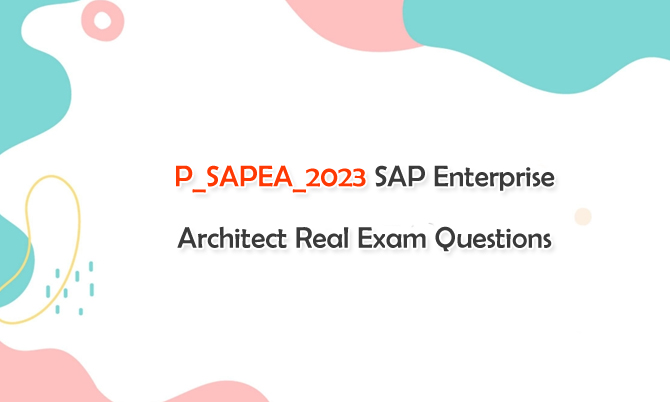P_SAPEA_2023 SAP Certified Professional - SAP Enterprise Architect exam tests your advanced knowledge and expertise in orchestrating the development of a holistic enterprise architecture model. The P_SAPEA_2023 certification is designed for IT professionals who play a pivotal role as SAP Enterprise Architects. These individuals are responsible for shaping and maintaining an organization's IT infrastructure, ensuring that it aligns seamlessly with the company's business strategy and operating model.
P_SAPEA_2023 Level and Exam Structure
SAP Certified Professional P_SAPEA_2023 exam is classified at the professional level, reflecting the depth of knowledge and experience expected of candidates. The P_SAPEA_2023 exam consists of 40 questions, and participants must achieve a minimum score of 80% to pass. The duration of the exam is 180 minutes, allowing candidates ample time to showcase their understanding of the intricacies of SAP Enterprise Architecture.
SAP P_SAPEA_2023 Key Competencies and Roles
Successful candidates of the P_SAPEA_2023 exam demonstrate their proficiency in key competencies, including:
1. SAP Enterprise Architecture Framework and Tool Set (≥12%): This section assesses candidates on their familiarity and ability to navigate SAP's architecture framework and toolset. It encompasses understanding the foundational elements that form the basis of SAP's enterprise architecture.
2. Architecture Vision and Roadmap (≥12%): Candidates are evaluated on their capability to craft a comprehensive architecture vision and roadmap. This involves strategic planning to align technology initiatives with the overall business strategy, ensuring a forward-looking and adaptive IT architecture.
3. Business Architecture (≥12%): This segment focuses on the candidate's grasp of business architecture principles. Successful candidates showcase their ability to link IT solutions with business objectives, creating a symbiotic relationship between technology and organizational goals.
4. Application, Data, and Technical Architecture (≥12%): This section assesses candidates on their understanding of the core components of enterprise architecture, including applications, data, and technical infrastructure. It covers the integration and optimization of these elements to meet organizational needs.
Continual Updates and SAP's Right to Modify
It's important to note that the topics covered in the P_SAPEA_2023 certification, as outlined above, are subject to change. SAP reserves the right to update the exam content, including topics, items, and weighting, to ensure that the certification remains relevant in the dynamic field of enterprise architecture.
P_SAPEA_2023 Real Exam Questions Help You Study
P_SAPEA_2023 real exam questions from Testpassport are good for studying and preparing for the actual exam. These questions provide a realistic simulation of the exam environment and help students familiarize themselves with the format and types of questions they may encounter. By practicing with P_SAPEA_2023 real exam questions, students can assess their knowledge and identify areas that require further study. This targeted approach allows students to focus on specific topics or concepts that they find challenging, ultimately enhancing their overall understanding and performance in the exam. Whether used for self-study or in conjunction with other study materials, P_SAPEA_2023 real exam questions are an effective tool to support exam preparation and boost confidence.
The P_SAPEA_2023 SAP Certified Professional - SAP Enterprise Architect certification is a hallmark of excellence for IT professionals engaged in enterprise architecture. It signifies advanced knowledge and expertise in aligning IT infrastructure with business goals, making certified individuals invaluable assets to organizations navigating the complex landscape of modern technology. As technology continues to evolve, staying abreast of the latest developments and acquiring certifications like P_SAPEA_2023 is instrumental for professionals aspiring to lead in the realm of SAP Enterprise Architecture.
